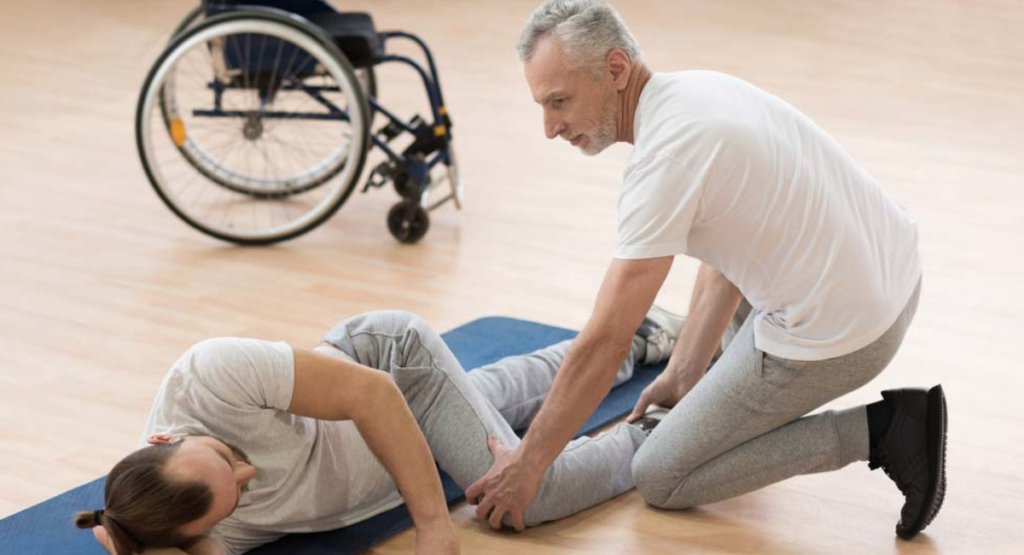The journey to recovery after a stroke is often marked by various challenges, and for those grappling with paralysis, the road can seem daunting. However, incorporating targeted exercises into a rehabilitation plan can be a transformative step toward regaining mobility and independence. In this blog, we will explore the importance of exercise for stroke patients with paralysis, outline specific exercises to get started, and provide insights into creating a personalized and effective rehabilitation routine.
What is the Significance of Exercise for Stroke Patients with Paralysis
Exercise for stroke patients with paralysis can bring several benefits to stroke patients, a few of which include:
Physical Benefits:
1. Muscle Activation and Strength: Exercise stimulates muscle activation, promoting strength and preventing muscle atrophy. This is particularly crucial for stroke survivors with paralysis, as it helps regain control and functionality.
2. Improved Range of Motion: Targeted exercises contribute to enhancing the range of motion in affected limbs. This is essential for performing daily activities and preventing joint stiffness.
3. Enhanced Circulation: Physical activity improves blood circulation, delivering oxygen and nutrients to damaged tissues. Improved circulation supports overall recovery and reduces the risk of complications.
4. Balance and Coordination: Exercise plays a pivotal role in improving balance and coordination, vital components for regaining stability and preventing falls.
Psychological Benefits:
1. Mood Enhancement: Engaging in regular exercise releases endorphins, promoting a positive mood and reducing feelings of anxiety or depression commonly associated with stroke recovery.
2. Increased Motivation: Achieving small milestones through exercise boosts motivation and instills a sense of accomplishment, fostering a positive mindset during the rehabilitation journey.
3. Enhanced Cognitive Function: Physical activity has cognitive benefits, contributing to improved focus, memory, and overall cognitive function. This is particularly important for stroke survivors working towards holistic recovery.
Guidelines for Exercise for Stroke Patients with Paralysis
Listed below are the guidelines that should be followed while performing exercise for stroke patients with paralysis.
1. Consultation with Healthcare Professionals: Before embarking on an exercise program, it is crucial to consult with healthcare professionals, including physicians and physical therapists. They can assess the individual’s condition, identify any potential risks, and provide tailored guidance on suitable exercises.
2. Begin with Passive Range of Motion (PROM) Exercises: Passive Range of Motion (PROM) exercises involve gently moving the affected limbs through their range of motion. These exercises are particularly beneficial for individuals with paralysis as they help maintain joint flexibility and prevent contractures.
Examples: Gentle arm and leg swings, and rotations of wrists and ankles.
3. Progress to Active Range of Motion (AROM) Exercises: As strength and control improve, gradually transition to Active Range of Motion (AROM) exercises. These involve the individual actively moving their limbs, contributing to muscle activation and coordination.
Examples: Seated leg lifts, arm raises, and circles.
4. Incorporate Strength Training: Strength training is essential for rebuilding muscle strength. Start with low-resistance exercises and gradually increase intensity as the individual gains strength.
Examples: Resistance band exercises, seated leg press, and bodyweight exercises (e.g., seated squats).
5. Focus on Balance and Stability: Balance exercises are crucial for preventing falls and enhancing overall stability. These exercises can be adapted based on the individual’s abilities, initially using support if needed.
Examples: Seated balance exercises, tai chi for seated individuals, and standing exercises with support (e.g., holding onto a sturdy surface).
6. Engage in Cardiovascular Exercise: Cardiovascular exercise contributes to improved circulation and overall cardiovascular health. Adapt activities based on individual abilities, starting with gentle movements.
Examples: Seated marching or cycling, arm ergometer exercises, and adapted aerobic exercises.
7. Utilize Assistive Devices: Incorporate assistive devices, such as canes or walkers, to provide support during exercises. These devices enhance safety and stability, allowing stroke survivors to focus on the quality of their movements.
8. Explore Water-Based Exercises: Aquatic therapy can offer a supportive and low-impact environment for individuals with paralysis. The buoyancy of water reduces the impact on joints, making it an excellent option for rehabilitation.
Examples: Water walking or marching, arm and leg movements in the water, and floating and stretching exercises.
9. Monitor Progress and Adjust: Regularly monitor progress and be open to adjusting the exercise routine based on individual capabilities. Gradual progression is key, and modifications may be needed to accommodate changes in strength and mobility.
How to Build a Supportive Environment?
For stroke patients to carry out their exercises effectively, the environment for them to exercise must be very supportive. The steps that can help you manage a supportive environment include:
1. Encouragement and Positive Reinforcement: Provide positive reinforcement and encouragement during exercise sessions. Celebrate small achievements and milestones to boost motivation.
2. Incorporate Variety: Keep the exercise routine diverse and engaging. Variety prevents monotony and encourages continued participation.
3. Set Realistic Goals: Establish realistic and achievable goals. Breaking down larger goals into smaller, manageable steps makes progress more tangible.
4. Consistency is Key: Consistency is crucial for seeing positive results. Create a realistic schedule for exercise sessions and adhere to it.
5. Social Support: Involve family members, friends, or support groups in the exercise routine. Social support enhances motivation and creates a positive environment.
Conclusion
Exercise for stroke patients with paralysis is a powerful tool in the journey toward recovery and improved quality of life. By incorporating a well-rounded exercise routine that addresses both physical and psychological aspects, individuals can make significant strides in regaining mobility, strength, and independence. Always consult with healthcare professionals to ensure that the chosen exercises are safe and suitable for the individual’s specific condition. The collaborative effort between healthcare providers, individuals, and their support network creates a foundation for a more empowered and fulfilling rehabilitation experience.
We are India’s first comprehensive continuum care provider. We provide multidisciplinary out of hospital care to acute and post-acute and chronically ill patients at our critical care facilities and your home.


